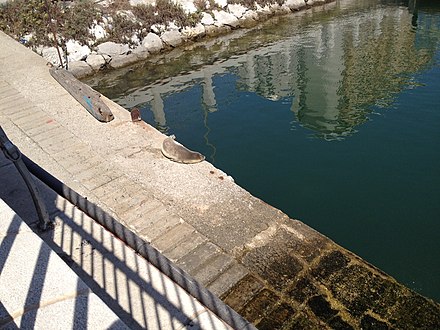Mediterranean monk seal
The Mediterranean monk seal (Monachus monachus) is a monk seal belonging to the family Phocidae. As of 2015[update], it is estimated that fewer than 700 individuals survive in three or four isolated subpopulations in the Mediterranean, (especially) in the Aegean Sea, the archipelago of Madeira and the Cabo Blanco area in the northeastern Atlantic Ocean.[3] It is believed to be the world's rarest pinniped species.[1] This is the only species in the genus Monachus.
This species of seal grows from approximately 80 centimetres (2.6 ft) long at birth up to an average of 2.4 metres (7.9 ft) as adults, females slightly shorter than males.[4] Males weigh an average of 320 kilograms (710 lb) and females weigh 300 kilograms (660 lb), with overall weight ranging from 240–400 kilograms (530–880 lb).[1][5][6][7] They are thought to live up to 45 years old;[5] the average life span is thought to be 20 to 25 years old and reproductive maturity is reached at around age four.
The monk seals' pups are about 1 metre (3.3 ft) long and weigh around 15–18 kilograms (33–40 lb), their skin being covered by 1–1.5 centimeter-long, dark brown to black hair. On their bellies, there is a white stripe, which differs in color and shape between the two sexes. In females the stripe is usually rectangular in shape whereas in males it is usually butterfly shaped.[8] This hair is replaced after six to eight weeks by the usual short hair adults carry.[5] Adults will continue to molt annually, causing their color vibrancy to change throughout the year.[9]
Pregnant Mediterranean monk seals typically use inaccessible undersea caves while giving birth, though historical descriptions show they used open beaches until the 18th century. There are eight pairs of teeth in both jaws.
Believed to have the shortest hair of any pinniped, the Mediterranean monk seal fur is black (males) or brown to dark grey (females), with a paler belly, which is close to white in males. The snout is short broad and flat, with very pronounced, long nostrils that face upward, unlike their Hawaiian relative, which tend to have more forward nostrils. The flippers are relatively short, with small slender claws. Monk seals have two pairs of retractable abdominal teats, unlike most other pinnipeds.
Very little is known of this seal's reproduction. As of 2020, it is thought that there are roughly 500 pairs of monk seals remaining in the world.[10] Scientists have suggested that they are polygynous, with males being very territorial where they mate with females. Although there is no breeding season since births take place year round, there is a peak in September, October, and November. Although mating will take place in the water, females will give birth and care for the pups on beaches or underwater caves. The use of underwater caves may have began in order to make predatory actions almost impossible as these caves are difficult to access. Because they will stay with the pups to nurse and protect, they use their stored fat reserves to nurse.[4] Data analysis indicates that only 29% of pups born between September and January survive. One cause of this low survival rate is the timing of high surf around the areas of breeding, creating a threat to young pups. As well, if a female determines that her environment is not a safe one, she can initiate an abortion, indirectly lowering the population.[10] Because of smaller populations there is an increase in genetic events such as inbreeding and lack of genetic variation. During other months of the year, pups have an estimated survival rate of 71%.[11]
.jpg/440px-Colonia_de_focas_monje_de_Cabo_Blanco_(1945).jpg)



